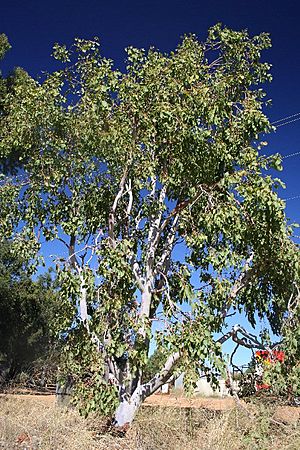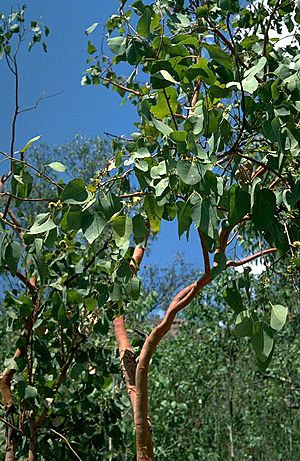Northern salmon gum facts for kids
Quick facts for kids Northern salmon gum |
|
|---|---|
 |
|
| Scientific classification | |
| Genus: |
Eucalyptus
|
| Species: |
bigalerita
|
| Synonyms | |
|
Eucalyptus pastoralis S.Moore |
|
The Eucalyptus bigalerita, also known as the northern salmon gum, Adelaide River white gum, or poplar gum, is a type of tree found only in north-western Australia. It has smooth bark, large leaves that can be triangular or round, and white flowers. Its flower buds grow in groups of seven, and its fruit looks like a cone or half-sphere.
Contents
About the Northern Salmon Gum
The Northern Salmon Gum is a tree that usually grows between 6 and 18 meters (about 20 to 60 feet) tall. It has a special woody swelling at its base called a lignotuber. This helps the tree regrow if it gets damaged, like from a bushfire.
Bark and Leaves
Its bark is smooth on both the trunk and branches. When new, it looks pale orange or creamy-pink. Over time, it fades to grey before peeling off.
Young trees and new shoots (called coppice regrowth) have dull, grey-green leaves. These leaves are shaped like triangles or hearts. They are about 7 to 18 centimeters (3 to 7 inches) long and 6.5 to 16 centimeters (2.5 to 6 inches) wide. Each young leaf has a stalk, called a petiole.
Adult leaves are usually glossy green on both sides. They are shaped like triangles or are mostly round. These leaves are typically 9 to 15 centimeters (3.5 to 6 inches) long and 7 to 15 centimeters (2.5 to 6 inches) wide. Their stalks are shorter, about 3 to 12 millimeters (0.1 to 0.5 inches) long. During the drier months, before the wet season begins, the tree often sheds its leaves.
Flowers and Fruit
The flower buds grow in groups of seven on a small stalk called a peduncle, which is usually 3 to 12 millimeters (0.1 to 0.5 inches) long. Each individual flower can either sit directly on the stem (called sessile) or have its own tiny stalk, called a pedicel, up to 9 millimeters (0.4 inches) long.
Mature flower buds are mostly round. They are about 6 to 12 millimeters (0.2 to 0.5 inches) long and 6 to 11 millimeters (0.2 to 0.4 inches) wide. They have a rounded or slightly beaked cap, called an operculum. This tree flowers between June and September, and its flowers are white.
After flowering, the tree produces a woody fruit. This fruit is a capsule shaped like a cone or half-sphere. It is 6 to 9 millimeters (0.2 to 0.4 inches) long and 8 to 12 millimeters (0.3 to 0.5 inches) wide. It sits on a pedicel up to 6 millimeters (0.2 inches) long.
Naming the Northern Salmon Gum
Eucalyptus bigalerita was first officially described in 1859 by a scientist named Ferdinand von Mueller. He published his description in a scientific journal.
What the Name Means
The second part of its scientific name, bigalerita, comes from two Latin words. "Bi" means "two" or "double," and "galeritus" means "wearing a hood." This name refers to the fact that the flowers of this species have a double operculum, or cap. Mueller specifically mentioned "operculo duplici" (double operculum) in his description.
Related Trees
The Northern Salmon Gum belongs to a small group of eucalyptus trees that are closely related to the "red gums." Other trees in this group include the White Gum (E. alba), Poplar Gum (E. platyphylla), E. tintinnans, Whitebark (E. apodophylla), and Kimberley White Gum (E. houseana). Among these, E. bigalerita is most similar to E. platyphylla and E. tintinnans.
Where the Northern Salmon Gum Grows
The Northern Salmon Gum is found in the northern parts of Western Australia and the Northern Territory.
Habitat in Western Australia
In Western Australia, you can find it growing along rivers and in low-lying flat areas in the Kimberley region. It prefers to grow in rich river soils (called alluvium) or sandy soils.
Habitat in the Northern Territory
In the Northern Territory, it grows across the entire Top End. This includes places like the Tiwi Islands, the Cobourg Peninsula, and as far south as Daly Waters.
Conservation Status
The Western Australian Government's Department of Parks and Wildlife has classified Eucalyptus bigalerita as "not threatened." This means it is not currently at risk of disappearing.
Growing This Tree
It is quite easy to grow the Northern Salmon Gum from its seeds. The seeds sprout readily, meaning they germinate easily.


